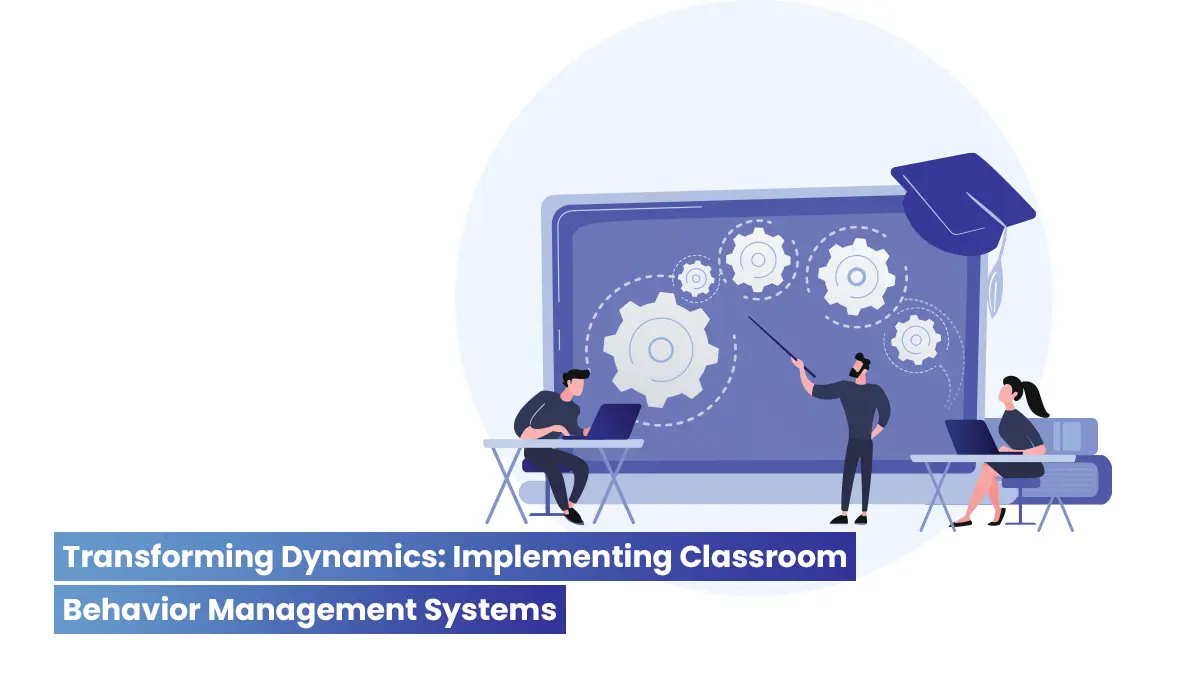Promoting a Positive Campus Culture: Using Behavior Management in Higher Education
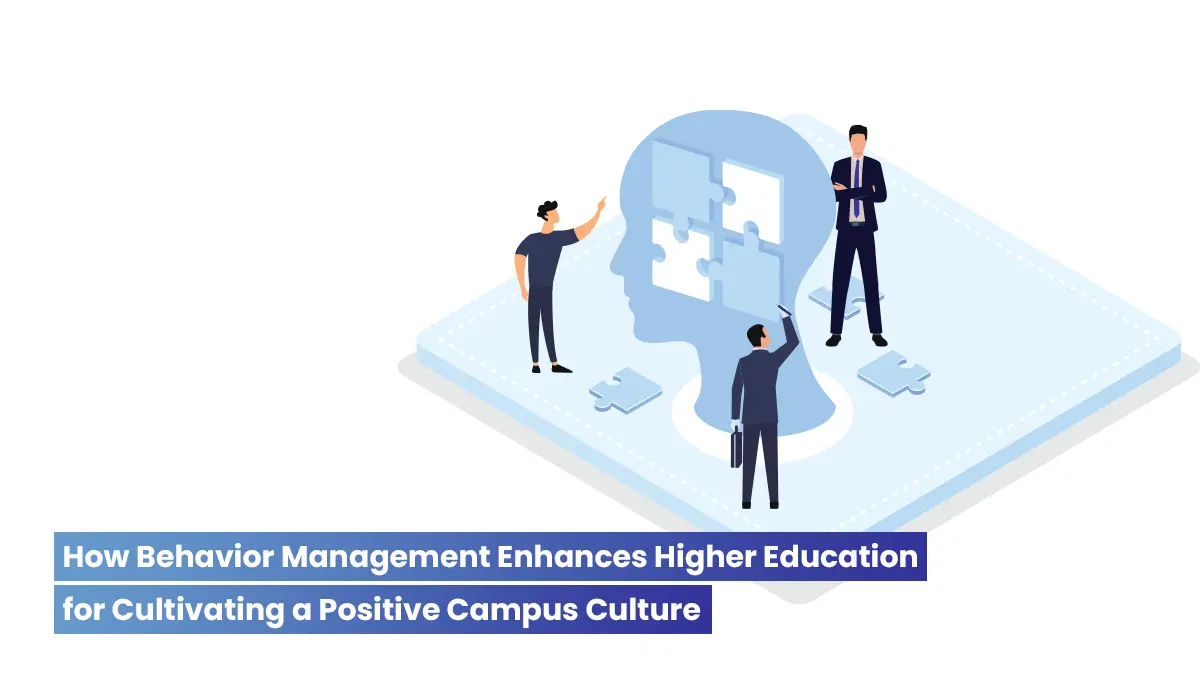
In the dynamic realm of higher education, fostering a positive campus culture is not only desirable but essential for academic excellence and holistic student development. The advent of data-driven insights has unveiled the remarkable potential of behavior management strategies in shaping the campus environment. According to recent data from the National Association of Student Personnel Administrators (NASPA), campuses that prioritize behavior management report higher student engagement rates, improved retention, and a more conducive atmosphere for learning.
In this blog, we delve into the pivotal role of behavior management in higher education, different ways of promoting it, and its far-reaching impact. By harnessing these insights, as higher education decision-makers you can proactively cultivate an environment where students thrive, faculty excel, and the entire campus community flourishes.
Understanding Behavior Management in Higher Education
Behavior management in the context of higher education refers to the deliberate and systematic efforts undertaken by educational institutions to guide, shape, and regulate student behavior in ways that contribute to a positive and conducive learning environment.
It involves the application of strategies, policies, and interventions to promote responsible conduct, foster a sense of community, and ensure that interactions within the campus community align with the institution's values and goals.

Benefits of Implementing Behavior Management
Implementing effective behavior management strategies offer a range of benefits that collectively contribute to promoting a positive campus culture.
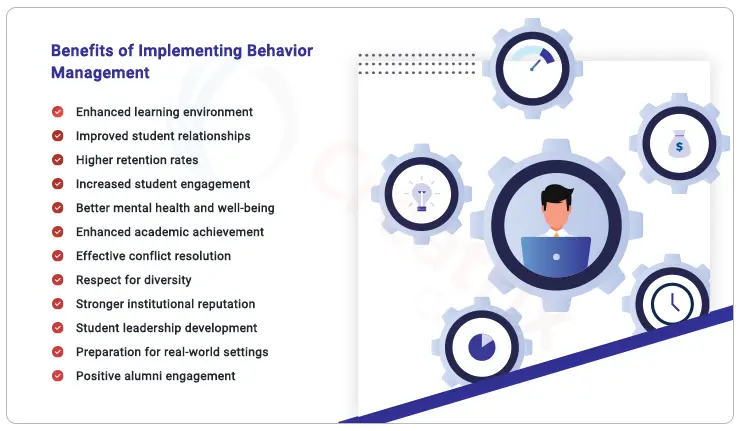
Creating a Framework for Behavior Management
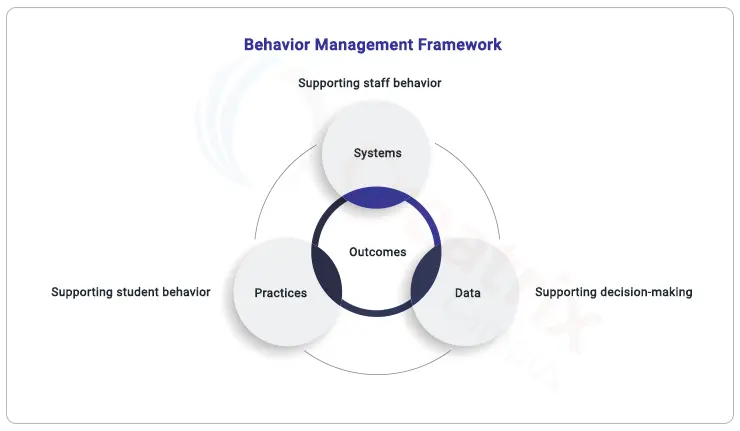
Developing a comprehensive behavior management framework is essential for fostering a positive and conducive learning environment within higher education institutions. Such a framework should be outcome-focused and should set the stage for guiding students, faculty, and staff in maintaining respectful and responsible behaviors, ultimately driving institutional decision-making and enriching campus culture.
Elements of an effective behavior management framework in Higher Education
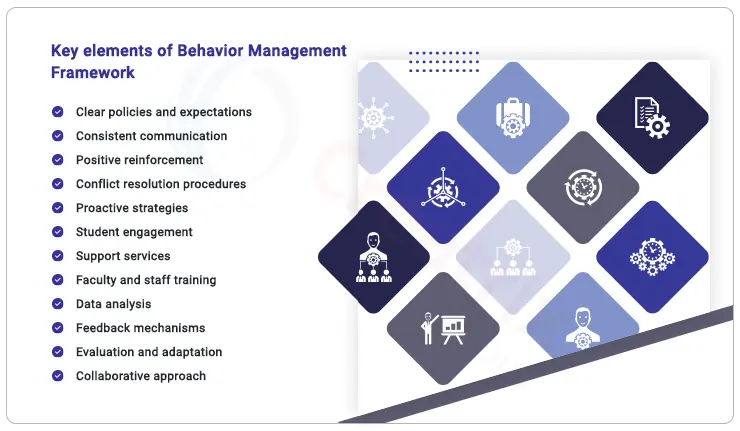
- Clear behavioral expectations and codes of conduct provide a foundation for understanding acceptable behaviors.
- Consistent communication about behavioral standards, consequences, and the rationale behind them ensures transparency and clarity.
- A well-defined reporting mechanism for behavior-related concerns facilitates prompt intervention and resolution.
- Encourage positive behaviors through recognition, rewards, and reinforcement mechanisms, while also having clear conflict-resolution procedures.
- Implementing proactive strategies like behavior management systems, and workshops to prevent behavioral challenges.
Some examples of behavior management policies and procedures include guidelines for classroom behavior, academic integrity, respectful communication, ethical use of technology, and respectful engagement in extracurricular activities. These policies can outline steps for addressing violations, from initial warnings to progressive disciplinary actions, reinforcing the institution's commitment to maintaining a positive campus culture.
Three ways to promote a positive campus culture
(i) Fostering positive student-staff relationships
Faculty and staff play a pivotal role in shaping and promoting a positive campus culture. They serve as role models and mentors for students, influencing their attitudes, behaviors, and overall experiences within the institution. By embodying professionalism, respect, and open communication, educators contribute to creating an environment where positive interactions thrive.
Strategies for building positive relationships
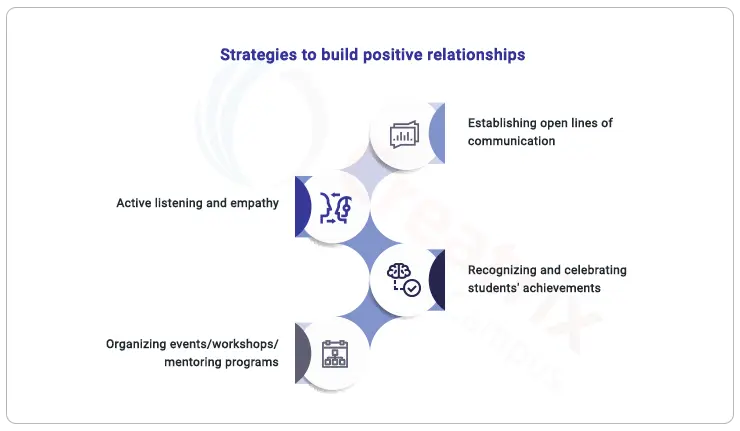
Building positive relationships between students and staff members involves several strategies. Establishing approachable and open lines of communication encourages students to seek guidance and support. Active listening and empathy foster understanding and trust, while recognizing and celebrating students' achievements and contributions further strengthen these relationships. Organizing informal events, workshops, and mentoring programs also provide opportunities for meaningful connections beyond the classroom.
Impact of Building Positive Relationship
Positive student-staff relationships have a profound impact on behavior management and campus culture. By nurturing positive interactions between students and staff, higher education institutions cultivate a campus culture where individuals thrive academically, emotionally, and socially. These relationships not only contribute to effective behavior management but also lay the foundation for a cohesive and harmonious community. The impact is shown in the image below.
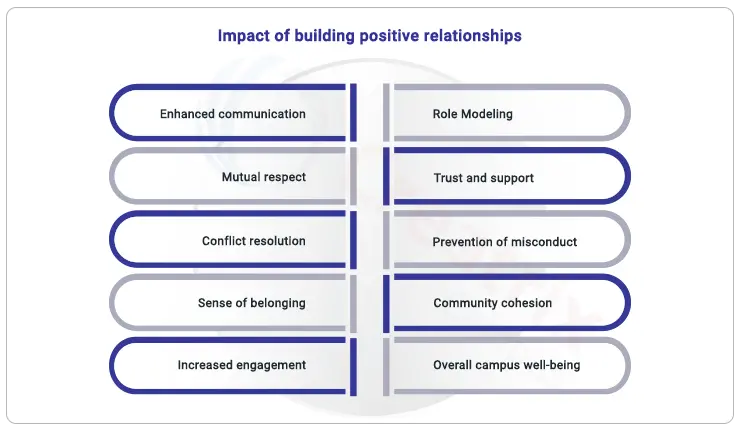
(ii) Encouraging student engagement and responsibility
Student engagement and responsibility are interconnected aspects that play a pivotal role in shaping a positive campus culture. When students are actively engaged in their academic and co-curricular activities, they take ownership of their learning journey, leading to a greater sense of responsibility for their actions. This sense of responsibility not only influences individual behavior but also contributes to a supportive and harmonious campus environment.
Strategies to promote student engagement and responsibility
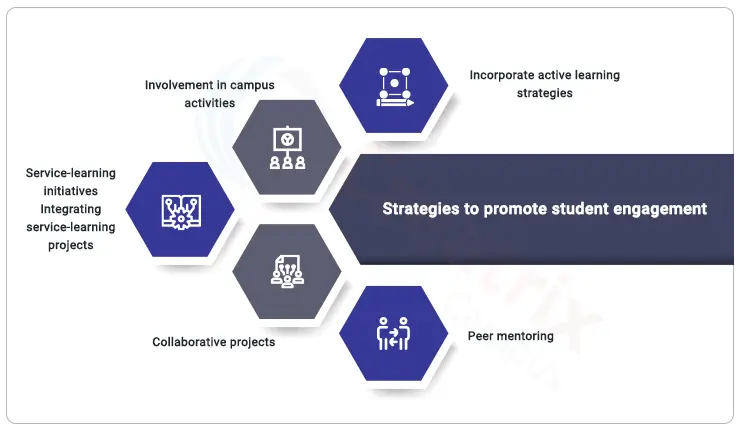
Active Learning Strategies: Incorporating interactive teaching methods, group discussions, and hands-on experiences can foster student engagement by making learning more dynamic and relevant.
Involvement in Campus Activities: Encouraging participation in clubs, organizations, and events provides students with opportunities to take on leadership roles and contribute to the campus community.
Service-Learning Initiatives: Integrating service-learning projects into the curriculum promotes responsible citizenship and engagement by connecting classroom learning with real-world issues.
Collaborative Projects: Assigning group projects and collaborative assignments encourages students to work together, fostering a sense of shared responsibility for the project's success.
Peer Mentoring: Pairing experienced students with newcomers for mentoring promotes a sense of responsibility in supporting each other's academic and personal growth.
(iii) Building a supportive community for students
A supportive community is the foundation of a thriving campus culture. It provides students with a sense of belonging, safety, and shared purpose, creating an environment where individuals can excel academically, emotionally, and socially. A strong community helps students feel valued and connected, enhancing their overall well-being.
Ways to build a strong community feeling among students
Orientation and Welcome Programs: Organizing orientation sessions and welcome events for new students helps them integrate seamlessly into the campus community.
Inclusive Policies and Practices: Implementing inclusive policies that respect diversity and equity fosters an environment where all students feel respected and valued.
Diverse Programming: Hosting cultural festivals, seminars, and workshops that celebrate diversity and encourage intercultural interactions promotes inclusivity.
Mentorship Programs: Pairing incoming students with experienced mentors helps build connections and provides guidance during their transition to campus life.
Open Dialogue Platforms: Creating spaces for open discussions and forums allows students to share their thoughts, experiences, and concerns, fostering a culture of understanding.
Implementing Proactive Behavior Management Approaches
Proactive behavior management focuses on preventing issues before they occur by promoting positive behaviors and addressing potential challenges in advance.
On campus, these strategies could include regular communication about expected behavior, offering workshops on stress management, providing mentorship programs, and creating a positive learning environment through engaging classroom activities.
Implementing proactive behavior management approaches manually may staff and faculty time. With the integration of behavior management software, educational institutions can take a proactive stance in addressing behavioral challenges. This software enables real-time monitoring and analysis of student behaviors, allowing for timely interventions. By utilizing predictive analytics, institutions can identify potential issues before they escalate and provide targeted support to at-risk students.
The behavior management software also facilitates the implementation of proactive strategies such as workshops, training sessions, and awareness campaigns. Institutions can customize these initiatives based on data insights, ensuring they effectively address prevalent concerns. Additionally, the software enables efficient conflict resolution procedures by streamlining communication and documentation.
Through collaboration between faculty, staff, and students, behavior management software enhances engagement and involvement in shaping policies and practices. Feedback mechanisms built into the software enable continuous improvement by incorporating student input. Regular evaluation of the software's impact ensures its effectiveness and allows for adaptive adjustments based on outcomes.
Evaluating and Adapting Behavior Management Strategies
Continuous evaluation of behavior management strategies is essential to ensure their effectiveness and alignment with evolving campus dynamics.
Assessment Methods: To assess strategy effectiveness, institutions can use surveys, feedback from students and staff, behavior trend analysis, and comparative studies with benchmarks from other campuses. A 360-degree evaluation software can help here.
Adapting Strategies: Institutions can refine existing strategies or introduce new ones based on evaluation results and feedback. This adaptive approach ensures that behavior management strategies remain relevant, impactful, and responsive to the changing needs of the campus community.
Creatrix Campus Student Behavior Management System
The Creatrix Campus Student Behavior or Conduct Management System is a comprehensive solution designed to foster a positive and respectful campus culture. With a focus on promoting responsible conduct and enhancing student experiences, this system empowers educational institutions to effectively manage student behavior and cultivate an environment conducive to learning and personal growth.
Key Features Creatrix Campus Student Behavior Management System
Behavioral Analytics: Utilize data-driven insights to identify behavior patterns, potential risks, and opportunities for improvement. This informed approach enables proactive intervention.
Incident Tracking: Streamline incident reporting and tracking processes to address behavioral issues promptly. Real-time monitoring helps prevent the escalation of concerns.
Customizable Policies: Tailor behavior management policies to match the unique values and expectations of your institution. Create a framework that resonates with your campus community.
Notification System: Automate communication by sending alerts to relevant stakeholders when behavioral incidents occur. This ensures swift responses and consistent communication.
Student Support Plans: Develop individualized plans to provide targeted assistance to students facing behavior-related challenges. These plans facilitate proactive support and guidance.
Positive Reinforcement: Recognize and reward positive behaviors to encourage responsible conduct and motivate students to contribute positively to the campus environment.
Collaborative Approach: Foster collaboration among faculty, staff, students, and administrators to uphold behavior standards and create a supportive community.
Reporting and Analysis: Access detailed reports and analytics to evaluate the effectiveness of behavior management strategies. Use this data to refine approaches and track progress.
Benefits of using Creatrix Behavior Management
- Helps cultivate an atmosphere of respect, responsibility, and inclusivity, enhancing the overall campus experience for students and staff.
- Identify potential issues early and provide timely support to students, minimizing negative outcomes.
- Streamline behavior management processes and reduce administrative burden through automation and centralized data storage.
- Make evidence-based decisions by leveraging behavioral analytics and trends to improve strategy effectiveness.
- By promoting responsible behavior and a positive environment, students can focus on their academic pursuits and personal growth.
Conclusion
Fostering a positive campus culture through effective behavior management is thus a pivotal step toward creating an environment where students thrive academically, socially, and emotionally. By implementing a comprehensive behavior management framework that encourages positive behaviors, resolves conflicts, and engages all stakeholders, higher education institutions can ensure a harmonious and conducive learning environment.
The benefits of such an approach extend far beyond academics, impacting overall student well-being and future success. As institutions strive for excellence in all facets, partnering with Creatrix Campus and its advanced behavior management software solution is a significant step forward.
Seamlessly integrating technology with strategies, Creatrix empowers institutions to effectively manage behaviors, monitor progress, and continuously enhance the campus culture. Embrace this opportunity to transform your campus into a thriving hub of positive experiences and academic achievements. Learn more about how Creatrix Campus can elevate your campus culture today by contacting us.



